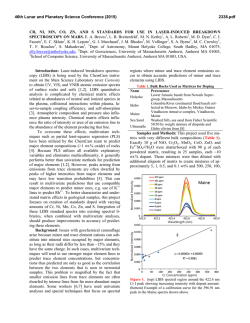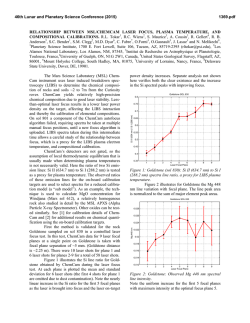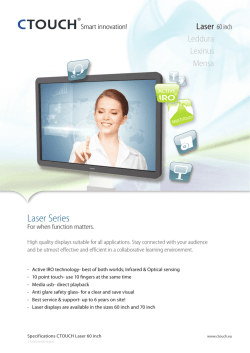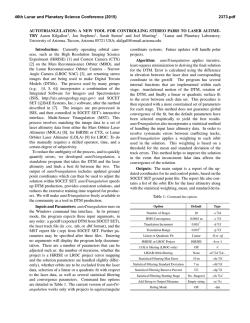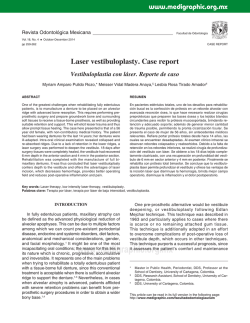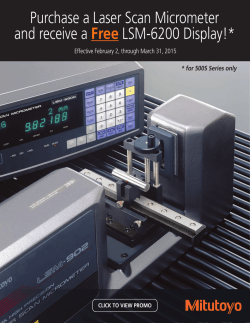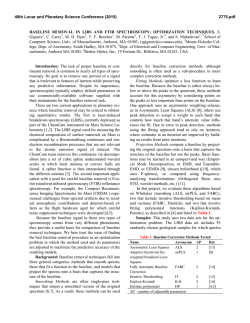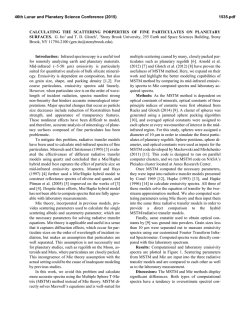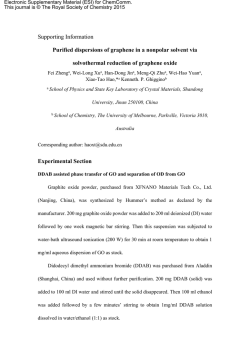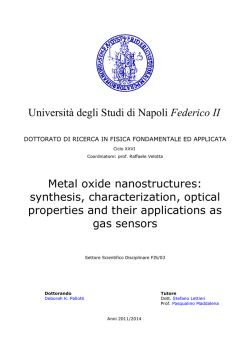
Developing a Relationship Between LIBS Ablation and Pit Volume
46th Lunar and Planetary Science Conference (2015) 1406.pdf DEVELOPING A RELATIONSHIP BETWEEN LIBS ABLATION AND PIT VOLUME FOR IN SITU DATING OF GEOLOGIC SAMPLES. D. Devimes1, B. A. Cohen1, P.-Y. Gillot3. 1NASA Marshall Space Flight Center, Huntsville AL 35812 ([email protected]), 3GEOPS Université Paris-Sud, France. Introduction: In planetary exploration, in situ absolute geochronology is an important measurement. Thus far, on Mars, the age of the surface has largely been determined by crater density counting, which gives relative ages. These ages can have significant uncertainty as they depend on many poorly-constrained parameters. More than that, the curves must be tied to absolute ages to relate geologic timescales on Mars to the rest of the solar system. Thus far, only the lost lander Beagle 2 was designed to conduct absolute geochronology measurements, though some recent attempts using MSL Curiosity show that this investigation is feasible [1] and should be strongly encouraged for future flight. Experimental: Developed at the MSFC through the NASA Planetary Instrument Definition and Development Program (PIDDP), the Potassium (K) –Argon Laser Experiment (KArLE) is one of several projects working on in situ geochronology [2, 3, 4]. The protocol is based on several instruments already used in planetary exploration. A laser ablates a rock under high vacuum and creates a plasma, whose spectrum yields elemental abundances, including K (Laser Induced Breakdown Spectroscopy, LIBS). The ablated material frees gases, including radiogenic 40Ar which is measured by a mass spectrometer (MS). The potassium and 40 Ar are related by the ablated mass. Because the very small mass displacement cannot be easily measured, the mass is calculated using the ablated volume and the density of the material. The determination of the chemistry, and therefore the mineralogy, is provided by the LIBS spectra and their treatment (univariate calibration, Partial Least Square, etc.) enabling the density to be determined. The volume of the pit is measured using optical imagery, for example, stereo imaging. Figure 1: Ablated pit after 1000 pulses. 3D model made with Keyence microscope VK-X100. Estimation of the ablated volume by using LIBS spectra: The ablation of rocks in high vacuum with hundreds of laser pulses produces a pit with depths of hundreds of µm. The shape and the size of the pits depend on different parameters including the optical setup and the properties of the target – for example, mineralogy, hardness, coupling to the laser energy, heterogeneity, etc. Among the projects working on geochronological instruments based on LA-LIBS-MS method, only Solé [5] has an approach based on the local thermodynamic equation. He assumes that the temperature and the number density of the plasma are constant, and so is able to relate the K peak intensity directly to number of K atoms, thereby obviating the need to measure sample mass. Other projects [2, 3, 4], including KArLE, use other laser and optic setups that may not be optimized in the same way, so must therefore measure the ablated volume and so the ablated mass. Several optical methods have been investigated for measuring the laser pit volume in situ, such as stereo pair reconstruction and Z-stacking [6]. The volume calculated with these methods were generally within 10-20% of the reference volume. We have also described a complementary approach for estimating pit volume [7] based on the LIBS spectra and specifically the evolution of the continuum intensity during the ablation. This relation was previously described on geologic samples by Lazic et al. [8] but under different conditions, with a continuum between 290 and 293 nm and for only 5 to 20 laser pulses. The number of pulses used for in situ geochronology is significantly larger, generally around 250 to 1000. We therefore began investigating the utility of this approach by defining a protocol and quantifying its uncertainties. Protocol and results: In our laboratory breadboard, we have the capability to image the pits directly using a 3D laser microscope Keyence VK-X100 (cf. Figure 1), which gives very high-resolution volume measurements for reference and development work. All the laser ablations and LIBS spectra were acquired on the setup of the Université Paris-Sud [4] and the volumes were measured at MSFC [2,6]. Previously, 4 different rock samples were studied and well characterized with LIBS spectra [9]. This preliminary study provided information about the minerals, their average sizes and their compositions. In this work, we subjected the same four samples to ablation with 250, 500 and 46th Lunar and Planetary Science Conference (2015) 1000 pulses under high vacuum under the same conditions used in the geochronology experiments. We repeated the experiments to create a database of about 180 pits, each with 5, 10, or 15 spectra, depending on the number of pulses. In contrast to the detailed treatments needed to quantify elements via LIBS spectra, we only need to substract the dark spectra to estimate pit volume. We examined the dataset to remove heterogeneous samples. If the composition changes significantly during the ablation, indicating that the mineralogy has changed, this technique cannot be applied. Heterogeneity is a bigger concern for rocks with minerals larger than or about the size of the laser beam, and when more pulses create a deeper pit. To define these heterogeneous pits, we control the variation of the intensity of the peak of the main elements. If the variation is significant, it clearly indicates that these pits are not relevant for this method. After removal of these data, we were left with 122 pits in the database. For the homogeneous pits, we correlated the difference of the intensity of the continuum between the first (shallowest) and the last (deepest) spectra with the volume measured with the laser microscope. The results give a linear correlation and a coefficient of determination of 0.94 (Figure 2). A “homogeneous” pit merely means that the average material is the same throughout the experiment – the material may be mixed phases but in a constant ratio and small grain size, or they could be single minerals of different types, such as feldspar or pyroxenes. That the relationship holds regardless of the material and indicates that this technique could be widely applied on geologic samples. Figure 2: Correlation between the difference of the continuum and the ablated volume of 122 homogeneous pits from 4 samples with 3 different number of pulses. The relative standard deviation (RSD) of this method begins to be valuable (less than 15%) when the ab- 1406.pdf lated volume is bigger than 6E106 µm3. There is less than 10% of uncertainty for ablated volumes larger than 9E106 µm3 , meaning it may be directly implemented in the geochronology protocol. Based on these first results, this method may prove useful in confirming the measurements given by optical techniques. One of the benefits of this approach is the simplicity of the technique and the use of already existing data, which is valuable for an in situ experimental setup. Upcoming work: We are extending study of this approach by conducting measurements on non-basaltic rock samples to understand whether this relationship holds over more geologic materials and may be used to estimate volume directly. In conducting this work, we are also gaining important insight into the physical parameters of the plasma (electron density, temperature, size, etc.) during ablation of hundreds to thousands of pulses under high vacuum. By doing this work, we expect to have a better understanding of the interaction of the laser and the sample to optimize in situ dating methods. References: : [1] Farley et al. (2013) Science, 343(6169). [2] Cohen et al. (2014) Geostandards and Geoanalytical Research, 10.1111/j.17511908X.2014.00319.x [3] Cho et al. (2011) PERC Planetary Geology Field Symposium, Abstract #30. [4] Devismes et al. (2013) EPSC 2013, Abstract #2013-71. [5] Solé (2014) Chemical Geology, 388, 9-22. [6] French et al. (2014) XLV, Abstract #1936, [7] Devismes et al. (2014) SCIX 2014, abstract #216. [8] Lazic et al. (2001) Spectrochim. Acta Part B, 56(6) :807– 820. [9] Devismes et al., (2014) 8th Mars Conference, abstract #1376. Acknowledgement: This research was supported by an appointment to the NASA Postdoctoral Program at the Marshall S.F.C., administered by Oak Ridge Associated Universities through a contract with NASA.
© Copyright 2025


